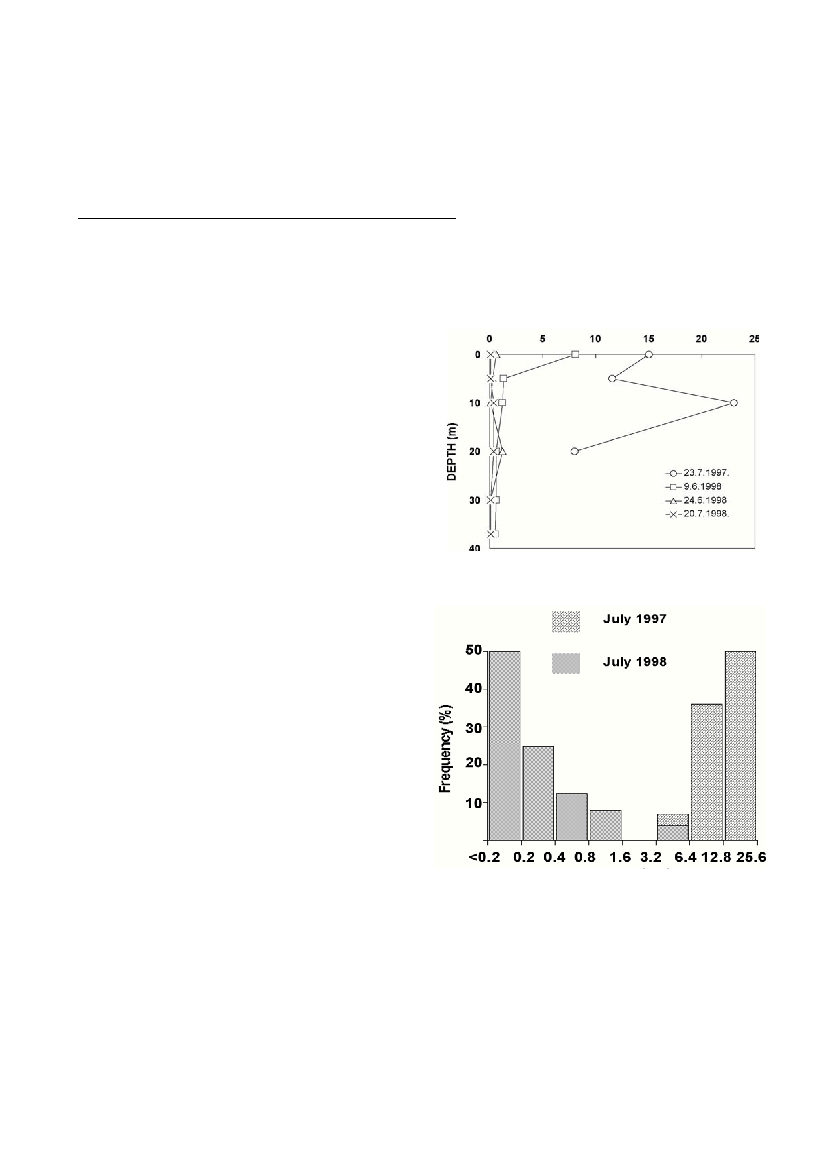Rapp. Comm. int. Mer Médit., 36,2001
138
Introduction
A major characteristic of a seawater sample containing colloidal
particles is its intrinsic instability due to continuing aggregation pro-
cesses and microbial activity. Sampling and sample processing should
be shortened as much as possible (1). The electrochemical particle
analysis, being direct, rapid and simple, meets these requirements and
also offers the possibility of single particle analysis (2,3).
Electrochemical adhesion sensor enables direct and simple recording
of attachment signals (millisecond duration) of reactive particles in
seawater samples over a time interval. A simple biological standard (a
cell suspension) can be used for calibration (4).
Material and methods
The electrochemical technique is based on the chronoamperometric
measurement of single events and attachment and spreading of surfa
c
e
-
a
c
t
ive particles at the dropping mercury electrode/seawater interfa
c
e
.
This is a modification of a widely used polarographic technique for
measurements of surfa
c
e
-
a
c
t
ive organic matter in aquatic environment.
Laboratory culture of the marine nano?agellate Dunaliella terti-
olectaButcher was used as a source of model particles. Dunaliella ter-
tiolectacells (6-10 µm) do not possess a cell wall, only a ?exible outer
membrane, and because of that behave as ?uid particles.
Results and discussion
Adhesion of reactive organic microparticles at the electrode result in
attachment signals of millisecond duration. Characteristic electrical
signals appearing as sharp spikes on current-time curves are the result
of random attachment of surface-active particles. The attachment sig-
nals appear at irregular intervals and with different amplitudes. The
amplitudes of attachment signals re?ect particle size, while the aver-
age signal frequency is directly proportional to the particle concentra-
tion in a sample. To interpret the recorded I-t curves in terms of parti-
cle abundance in the sample we conducted the series of calibrating
experiments using suspensions of Dunaliella tertiolectacells in sea-
water under identical experimental conditions. The plots of frequency
of attachment signals as function of cell density are used as calibration
curve. The calibration curves are used to determine the abundance of
surface-active particles (
=
1 µm).
Monitoring of reactive particle abundance in Northern Adriatic was
undertaken after the dramatic event of massive macroaggregation in
summer 1997 (5). Figure 1a presents the depth distribution of
microparticles at an off-shore station in Northern Adriatic in July 1997
and in the same period 1998 (6). The range of particle abundance in
1997 is an order of magnitude higher than in the same period during
summer 1998 (figure 1b).
Maximum microparticle concentration in seawater before the phe-
nomenon reached 5x10
7
/l which can be taken as a critical treshold for
the onset of the macroscopic phase formation (3).
Bibliographic references
1 - Buffle J. and Leppard G.G., 1995. Characterization of aquatic colloids
and macromolecules. 2. Key role of physical structures on analytical
results,Environ. Sci. Technol., 29: 2176-2184.
2 – Zutic V. and Svetlicic V., 2000. Interfacial processes. In:Wangersky
P. (ed.), The handbook of environmental chemistry, vol.5 part D.
Springer-Verlag, Berlin Heidelberg, pp.149-165.
3 – Zutic V., Svetlicic V., Ivosevic N. and Kovac S. Link between
aggregation and interfacial processes: Physico-chemical basis of
magroaggregate formation in Northern Adriatic, UNEP/MAP Tech.
Reports Series, Athens, in press.
4 – Kovac S., Kraus R., Gecek S. and Zutic V., 2000. Cell suspension as
a Model System for Electrochemical Analysis,Croat. Chem. Acta, 73:
279-291.
5 – Degobbis D., Fonda-Umani S., Franco P., Malej A., Precali R. and
Smodlaka N., 1995. Changes in the Northern Adriatic ecosystem and the
hypertrophic appearance of gelationous aggregates,Sci.Tot. Environ.,
165: 43-58.
6 – Croatian national monitoring program “Systematic study of the
Adriatic Sea as the basis for sustainable development of Republic of
Croatia”, 1998-
Figure 1a. Depth distribution of microparticle concentration (N)
in seawater samples from a Northern Adriatic station (SJ 107;
45°02.8’N, 13°19.0’E) (5).
Figure 1b. Comparision of frequency distributions of organic
microparticle concentrations in Northern Adriatic in summers
of 1997 and 1998. The seawater samples were taken at stan-
dard depths at six equidistant stations along the transect
Rovinj (Istrian coast) - the Po delta (5).
MONITORING OF REACTIVE MICROPARTICLES DISTRIBUTION IN THE NORTHERN ADRIATIC SEA
S. Kovac*, N. Ivosevic, R. Kraus, V. Zutic, V. Svetlicic
Center for Marine and Environmental Research, Rudjer Boskovic Institute, Zagreb, Croatia
kovac@rudjer.irb.hr
Abstract
The purpose of this study is monitoring of reactive microparticles in seawater and design of an early warning system for critical evolution
in particle aggregation. Dropping mercury electrode was used as the adhesion sensor for the monitoring of microparticles distribution in
the seawater samples from the Northern Adriatic Sea. The technique we used was chronoamperometry of oxygen reduction at the potential
of maximal attraction. Dunaliella tertiolectacells were used as model particles.
Keywords: Adriatic Sea, electrochemistry, monitoring, particle aggregation

